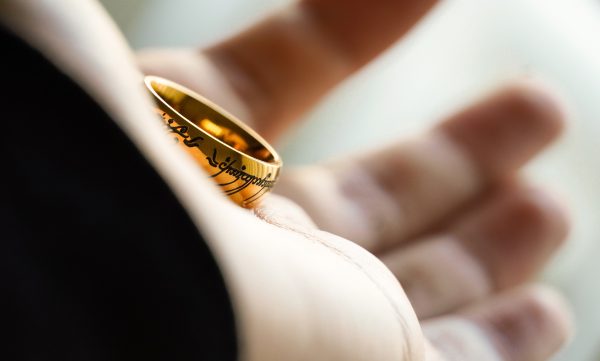The Hobbits (1993, directed by Timo Torikka)
Hobitit, a nine-episode miniseries released on Finnish TV, is probably the most difficult of these media to find—at least through legitimate methods like streaming or DVD. Which is a shame because it’s perhaps the best Lord of the Rings adaptation before Jackson’s trilogy arrived.
Based on a 1988-1989 summer stage show performed in Suomenlinna, this miniseries reused some of the same actors and technicians. Timo Torikka, who played Pippin in the stage show, served as writer and director for the miniseries.
The first episode shows a crowd of young hobbits convincing an ancient hobbit to tell them the story of Sam and Frodo. He tells it from a book, from Bilbo finding the ring to Frodo leaving for the Gray Havens. As the ancient hobbit tells the story, it becomes clear that he is Samwise Gamgee.
Watching the episodes back-to-back takes about three and a half hours—roughly the time for watching Jackson’s extended cut of The Fellowship of the Rings. The miniseries is apparently about half the length of the stage play it was based on.
The Hobbits has many of the same flaws as the projects discussed earlier. There’s a great deal of blue screen, much of it obvious. The limited sets are often obvious. There are some unusual music choices—such as a bluesy guitar theme for Gollum.
However, unlike most of the projects discussed here, the miniseries has a clear direction and sense of craft. Yes, it includes scenes that are terribly clunky in other media—like Tom Bombadil meeting the hobbits. However, here Bombadil is depicted like a somber indigenous shaman (wearing brown beaded garments, never smiling) rather than a jolly children’s TV host he appears in The Keepers. So, while Bombadil still feels like a side trail, he fits the rest of the story’s serious epic tone.
Yes, the blue screen often needs improvement. However, this time, the lighting crew knows how to accommodate that—creating shadows for the Mordor scenes so it’s not obvious where the actors end and the false backgrounds begin.
Yes, key scenes are removed, mostly anything requiring heavy special effects or crowds. Frodo blacks out after being stabbed by the Black Riders, and the scene cuts to him waking up in Rivendell. Gandalf tells the group to leave Moria without him, goes down a corridor, and then is seen falling down a chasm with no mention of a Balrog. Once the fellowship breaks down, the story focuses on Frodo and Sam—meaning the script omits the Two Towers and Return of the King material about Rohan, Helm’s Deep, and Gondor. Since Frodo and Sam never need Saruman, the plot shows the Scouring of the Shire, but Saruman’s death happens offscreen.
However, most of these omissions don’t feel like plot holes because the miniseries states from the start that it will focus on part of the story. It’s not titled The Lord of the Rings. It’s titled The Hobbits. Sam Gamgee’s narrator role firmly sets this narrative in the hobbits’ perspective. Hence, leaving out most of the big set pieces feels like a deliberate artistic choice rather than cheap cost-cutting.
Yes, there are a couple of eccentric choices that fans would find odd today. Most notably, Boromir is depicted as a proto-samurai warrior. His hair is in a topknot. His armor looks Japanese. His sword is a samurai sword. His shield looks like a haka bamboo hat. The depiction will surprise viewers who grew up with the European-looking warriors of Jackson and Bakshi’s movies. However, even this odd choice makes sense in its own way. Boromir is a warrior Prince with a deep sense of tradition, family allegiance, and honor—all values that fit a samurai warrior.
For every eccentric choice, there is a daring one that pays off. Most notably, a close look at the credits reveals that the same actor, Kari Väänänen, plays Gollum and plays Aragorn. His body looks no different (same height, same general body shape), but his hair is shaved, his skin covered in makeup, and his body language is entirely different. It is a shocking transformation, and it works. No one today (certainly not in Hollywood) would take that kind of casting risk on a fantasy film. The budgets have become too big, the decisions too corporate.
The Hobbits is not what we now call prestige TV. It’s not cinematic as Jackson’s trilogy. However, it is above almost every project listed here—and a clear step above comparative projects like the BBC Narnia adaptations. This would probably be the best Tolkien adaptation available if Jackson’s films never appeared.
Come back next week as we wrap up this series with some final thoughts.

